Introduction
Here are some examples of exercises for you to try. The exercises may be suggested for a condition or for rehabilitation. Start each exercise slowly. Ease off the exercises if you start to have pain.
You will be told when to start these exercises and which ones will work best for you.
How to do the exercises
Calf stretch (bilateral, knees straight)
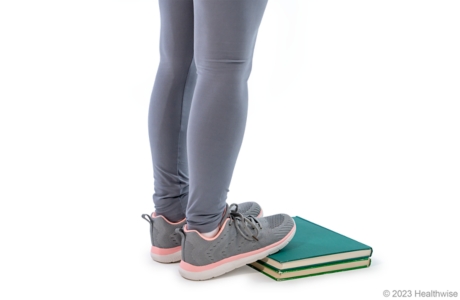
slide 1 of 9
slide 1 of 9, Calf stretch (bilateral, knees straight),
- Place a book on the floor a few inches from a wall or counter, and put the balls of your feet on it. Your heels should be on the floor. The book needs to be thick enough so that you can feel a gentle stretch in your calf. If you are not steady on your feet, hold on to a chair, counter, or wall while you do this stretch.
- Keep your knees straight, and lean forward until you feel a stretch in your calf.
- To get more stretch, add another book or use a thicker book.
- Hold the stretch for 15 to 30 seconds.
- Repeat 2 to 4 times.
Calf stretch (bilateral, knees bent)
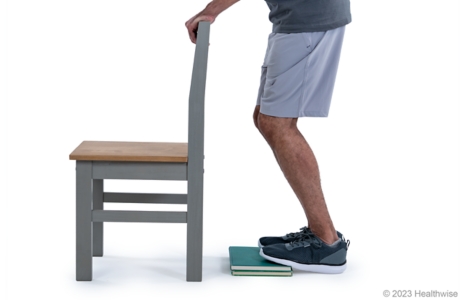
slide 2 of 9
slide 2 of 9, Calf stretch (bilateral, knees bent),
- Place a book on the floor, and put the balls of your feet on it. Your heels should be on the floor. The book needs to be thick enough so that you can feel a gentle stretch in your calf. If you are not steady on your feet, put the book a few inches from a chair, counter, or wall that you can hold onto as you do this stretch.
- Bend your knees, and lean forward until you feel a stretch in your calf.
- To get more stretch, add another book or use a thicker book.
- Hold the stretch for 15 to 30 seconds.
- Repeat 2 to 4 times.
Big-toe flexor stretch
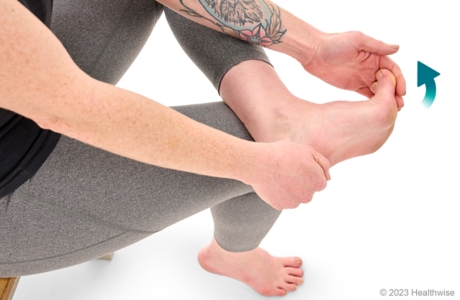
slide 3 of 9
slide 3 of 9, Big-toe flexor stretch,
- Sit in a chair, and put your affected foot across your other knee.
- Grasp your heel with one hand and then slowly pull your big toe back with your other hand. Pull your toe back toward your ankle until you feel a stretch along the bottom of your foot.
- Hold the stretch for 15 to 30 seconds.
- Repeat 2 to 4 times.
- It's a good idea to repeat these steps with your other foot.
Big-toe extensor stretch
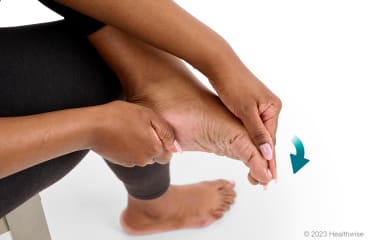
slide 4 of 9
slide 4 of 9, Big-toe extensor stretch,
- Sit in a chair, and put your affected foot across your other knee.
- Grasp your heel with one hand and then slowly push your big toe down with your other hand. Push your toe down and away from your ankle until you feel a stretch along the top of your foot.
- Hold the stretch for 15 to 30 seconds.
- Repeat 2 to 4 times.
- It's a good idea to repeat these steps with your other foot.
Ankle alphabet
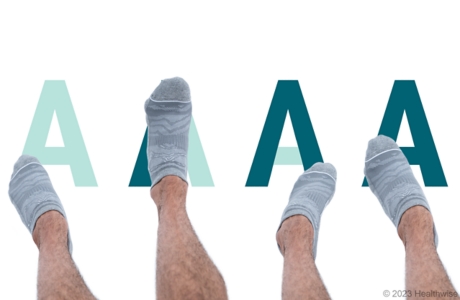
slide 5 of 9
slide 5 of 9, Ankle alphabet,
- Sit in a chair with your feet flat on the floor. (You can also do this exercise lying on your back with your affected leg propped up on a pillow).
- Lift the heel of your affected foot off the floor, and slowly trace the letters of the alphabet.
- It's a good idea to repeat these steps with your other foot.
Resisted ankle dorsiflexion

slide 6 of 9
slide 6 of 9, Resisted ankle dorsiflexion,
- Tie the ends of an exercise band together to form a loop. Attach one end of the loop to a secure object, or shut a door on it to hold it in place. (Or you can have someone hold one end of the loop to provide resistance.)
- Sit on the floor or in a chair, and loop the other end of the band over the top of your affected foot.
- Keeping your knee and leg straight, slowly flex your foot back toward you so you are pulling back on the exercise band. Then slowly return to the starting position.
- Repeat 8 to 12 times.
- It's a good idea to repeat these steps with your other foot.
Towel scrunch

slide 7 of 9
slide 7 of 9, Towel scrunch,
- Sit in a chair, and place your affected foot on a towel on a hard floor (not a floor with carpet).
- Scrunch the towel toward you with your toes. Then use your toes to push the towel back into place.
- Repeat 8 to 12 times.
- It's a good idea to repeat these steps with your other foot.
Make this exercise more challenging by placing a weighted object, such as a soup can, on the other end of the towel.
Resisted ankle eversion
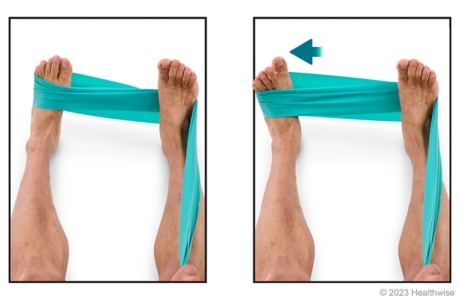
slide 8 of 9
slide 8 of 9, Resisted ankle eversion,
- Sit on the floor with your legs straight.
- Hold both ends of an exercise band in one hand and loop the band around the outside of your affected foot. Then press your other foot against the band.
- Keeping your leg straight, slowly push your affected foot outward against the band and away from your other foot without letting your leg rotate. Then slowly relax.
- Repeat 8 to 12 times.
- It's a good idea to repeat these steps with your other foot.
Resisted ankle inversion
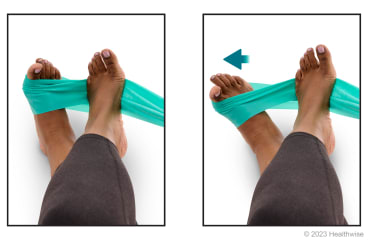
slide 9 of 9
slide 9 of 9, Resisted ankle inversion,
- Sit on the floor with your legs straight out in front of you. Cross your good leg over your affected leg.
- Hold both ends of an exercise band in one hand and loop the band around the inside of your affected foot. Then press your other foot against the band.
- Keeping your legs crossed, slowly push your affected foot against the band so that foot moves away from your other foot. Then slowly relax.
- Repeat 8 to 12 times.
- It's a good idea to repeat these steps with your other leg.
Current as of: July 31, 2024
Author: Ignite Healthwise, LLC Staff
Clinical Review Board
All Healthwise education is reviewed by a team that includes physicians, nurses, advanced practitioners, registered dieticians, and other healthcare professionals.

